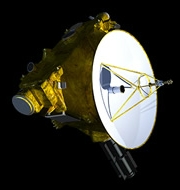NASA extends New Horizons mission
The National Aeronautics and Space Administration (NASA) has given its approval to extend New Horizons mission to investigate a mysterious object deep in the Kuiper Belt.
In the extended mission New Horizons space probe will investigate a mysterious object known as 2014 MU69 located deep in the Kuiper Belt.
2014 MU69: It is an ancient object considered one of the early building blocks of the solar system. It lies about 1.5 billion kilometres beyond Pluto and is roughly 45 kilometres in diameter. Its exploration may help to give insights on the building blocks of the solar system.
Other decisions taken by NASA
- Dawn spacecraft to remain at the dwarf planet Ceres rather than changing course to the main belt asteroid Adeona.
- Extension of the Mars Reconnaissance Orbiter (MRO), Mars Atmosphere and Volatile EvolutioN (MAVEN)
- Extension of the Opportunity and Curiosity Mars rovers, Mars Odyssey orbiter, Lunar Reconnaissance Orbiter (LRO)
- Extension to NASA’s support for the European Space Agency’s (ESA) Mars Express mission.
About New Horizons
- New Horizons is an interplanetary space probe that was launched as a part of NASA’s New Frontiers program. It was launched on January 19, 2006.
- It is engineered by the Johns Hopkins University Applied Physics Laboratory (APL) and the Southwest Research Institute (SwRI).
- Mission: The primary mission is to perform a flyby study of the Pluto system. The secondary mission to fly by and study one or more other Kuiper belt objects (KBOs).
- Mission Status: On July 14, 2015, New Horizons flew 12,500 km above the surface of Pluto, making it the first spacecraft to explore the dwarf planet. The flyby study ad confirmed presence of frozen methane on Pluto’s surface.
- After completing flyby mission of Pluto, New Horizons has maneuvered for a flyby of KBO 2014 MU69. It expected to take place on January 1, 2019.
About Kuiper belt
- Kuiper belt is a region of the solar system beyond the planets, extending from the orbit of Neptune. It consist mainly small bodies or remnants from the solar system’s formation.
- It is similar to the asteroid belt, although it is far larger — 20 times as wide and 200 times as massive.
- The Kuiper belt objects (KBO) are composed largely of frozen volatiles (termed ‘ices’), such as methane, ammonia and water.
- Kuiper belt is home to at least three dwarf planets — Pluto, Haumea and Makemake. Pluto, discovered in 1930, is considered its largest member.
Month: Current Affairs - July, 2016
No Comments
Leave a Reply
You must be logged in to post a comment.



ramsh
July 8, 2016 at 1:31 pmthanks… good information
ramsh
July 8, 2016 at 1:31 pmthanks… good information